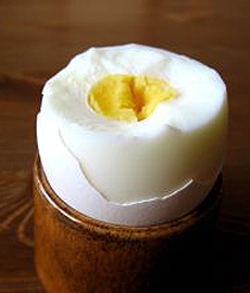ARTICLE: The Perfect Hard-Boiled Egg
 Struggle no longer: Make the perfect hard- boiled egg. Photo by Pontus Edenberg | IST. |
With holiday season approaching, those favorite deviled egg recipes will be coming out of the drawer. Have you ever wondered why some people make perfect hard-boiled eggs, and for others it’s such a chore? There’s actually a technique to making perfect boiled eggs, to avoiding that green ring around the yolk, to getting the yolk exactly centered and to cooking eggs that are a cinch to peel. Here is the egg-cellent solution, as well as egg nutrition and egg facts. Here’s one mystery solved: The difference between brown eggs and white eggs is simply the color of the hen! The reason brown eggs tend to cost more is because brown hen varieties are larger, and consume more feed. It’s that simple! If you want to learn the secrets of organic eggs, read our separate article. | |



Darlene said,
November 16, 2007 @ 9:51 am
Not all brown hens are larger. Bantams are small chickens, and they can produce brown eggs.
It may be true that the specific breeds of hens employed by egg factories to produce brown eggs are larger and consume more feed than their white-egg-producing counterparts. But, this would not be the only factor contributing to a higher price for brown eggs.
One factor affecting the price of brown eggs is market demand, of course.
Back to the topic of the size and color of the hen… Some varieties of chickens are genetically more efficient than others at converting the nutrition in the feed they are given into eggs. There is no direct correlation between the size of a chicken and its ability to convert feed to eggs.
Also, older hens tend to be larger and lay fewer, larger eggs which would be sold at a higher price.
Here are some of the things that affect the cost of egg-production: lighting (how many hours/day, what kind of light, at what age the chickens are exposed to light), vaccinations, space, water, heat, efficiency of egg-collection, efficiency of distribution, timing of molting, packaging.
So, its not as simple as it appears at first glance.
I love your blog, by the way!
Nibble Editors said,
November 22, 2007 @ 8:46 am
Darlene’s point about Bantams is well taken, and her comments are true for hobbyists who keep chickens or for farmers who have a small coop and sell a few eggs at farm stands. However, large, commercial egg producers have efficient operations. Pursuant to her points above, older, inefficient layers would be removed from the flock, and the operations (housing, feed, vaccination, etc.) would be optimized to improve profit margins. By the way, there is nothing more wonderful than farm-fresh eggs. If you come across them, bring them home and make yourself some scrambled eggs immediately. Heaven! The fresher your eggs, the better your cakes, too.